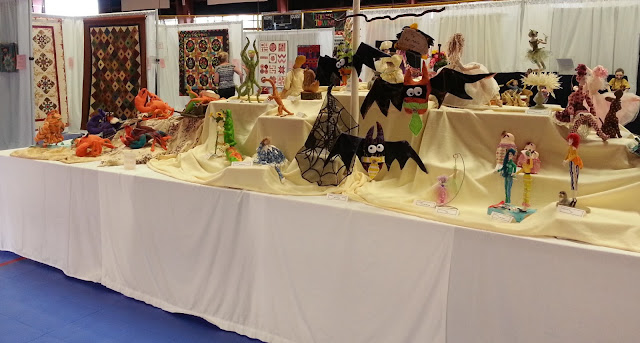I had the pleasure of spending some time with Kathryn Elms
of
Azumi Japanese Embroidery Studio from Roswell, NM when we were at the
Albuquerque Fiber Arts Fiesta. The first time I was in her booth I
was amazed at the framed pieces I saw. I spoke with her husband about it and he
walked me through piece by piece and explained the different levels.
The next morning before the show opened I took Alan by to
see what I was so excited about. This time Kathryn was free and explained
some more about the process. She had a Power Point presentation that showed the
history of Japanese Embroidery and the process.
She studied at the
Japanese Embroidery Center in Atlanta,
GA. This is the main source of education everywhere in the world, except
Japan. It was founded in 1989. There are ten levels of instruction and one needs
to complete all ten and pass their final in order to teach Japanese Embroidery.
There is a lot more to it than what we think of when we
think of embroidery. Think of the most beautiful kimono you have ever seen and the embroidery on it. This is the kind of embroidery I'm referring to.We are used to grabbing some fabric, needles and either
perle cotton, floss or silk ribbon and that’s it. These are the tools that are
used in Japanese Embroidery.
 |
| Tools for Japanese Embroidery |
The fabric used is silk as is the thread. The designs are
hand drawn onto the fabric at the
Japanese Embroidery Center or JEC. Along with each
design you get what is called a cartoon and a color version. The cartoon is
where you document your stitches, threads, etc. That way if you want to
reproduce it or in Kathryn’s case teach it, she has a record of what she did.
These are very intricate designs. This is the design that she was working on in
her booth.
 |
| The design Kathryn was working on. You can also see the thread she uses |
The embroidery is all done in a frame, similar to a quilting frame. The fabric is pulled
drum tight and the first session of the five day Phase 1 class focuses on the
mechanics such as how to get the piece in the frame properly and how the tools
are used.
 |
| Kathryn Elms at work. She is using her left hand to help manipulate the thread. You don't just pull it through the fabric the way you would for a RedWork design. |
The thread is silk and has 12 threads in a strand. There are
techniques such as couching where a single strand is used. This is doubled and
then is hand twisted. I played with some of Kathryn’s thread scraps. It is so
soft and smooth. Just touching the thread is a very zen-like experience.
This is the Phase 1 project. It consists of
five days of classes, studying for 6 hours a day. That gives you the basics but
just like in quilting and stitching classes, you learn the technique. Most of
the time we don’t complete the project in class and that is definitely the case
here.
 |
| Phase 1 Class Project |
There are over 40 different Japanese Embroidery stitches
to learn. Each phase of instruction adds more stitches and techniques. When you
get to Phase 10, you go to the
Japanese Embroidery Center to work on this
project. It is a week of instruction. This is your “final.” They make sure that
you have mastered every one of the stitches. When you have completed this and
passed, you can then become an instructor. This is Kathryn’s Phase 10 piece.
 |
Phase 10 Project
|
Here is a close up of the same piece.
I am absolutely fascinated with this. There was something
very peaceful about the process. Meditation is actually incorporated into the instruction. One of the things that Kathryn told me is that
her master teacher told her over and over again when she was learning that you
need to forgive yourself. I felt so encouraged by this. The philosophy is that
your work is your history. You learn from each phase and each project. So
forgive yourself if you aren't perfect. Learn from the experience and you’ll do
better as you progress. This is the way I teach too and I think for most people
it makes the learning process more fun.
Happy Stitching,
Carol



















